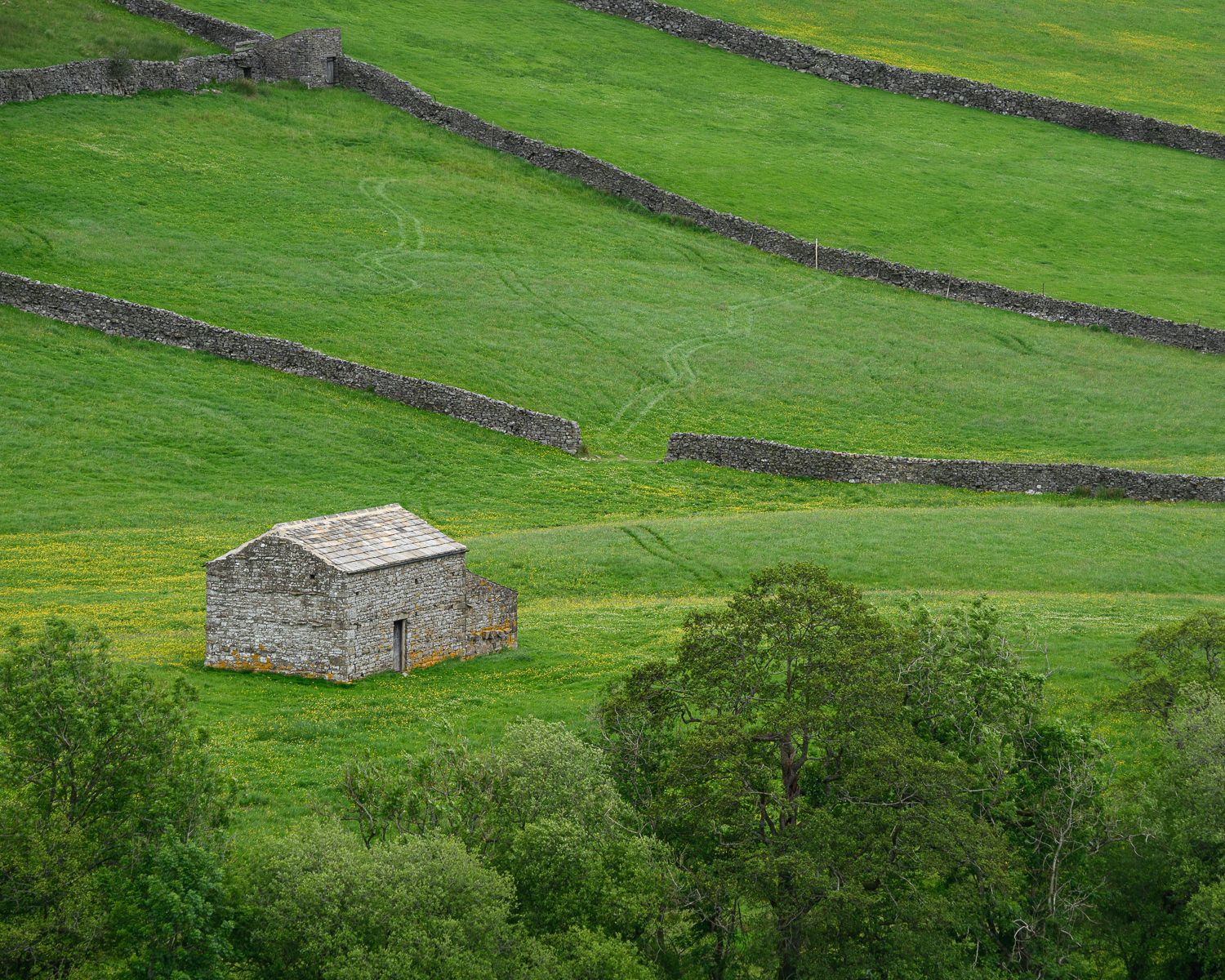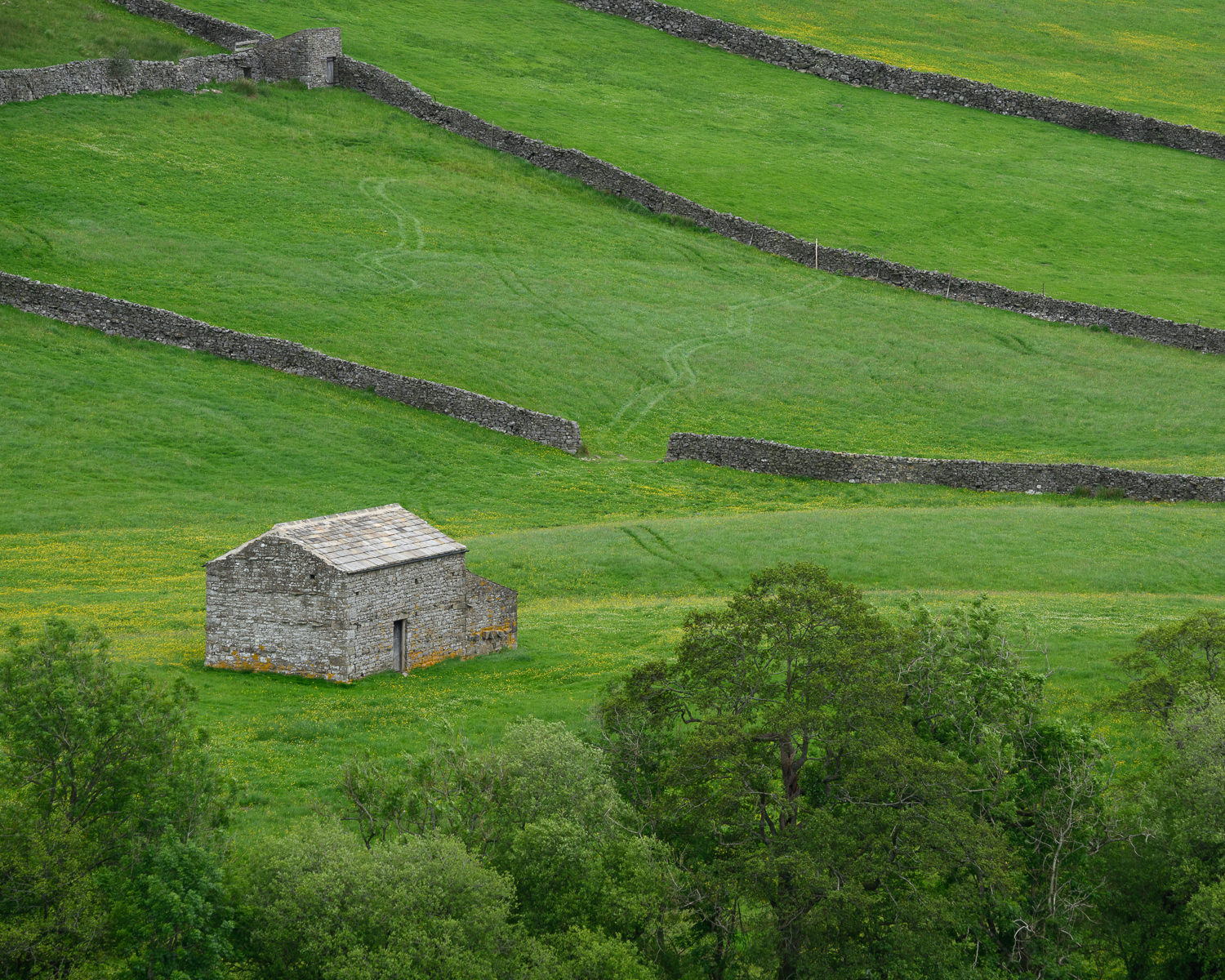
Nikon Z8 with Nikkor Z 100-400mm f/4.5-5.6 VR S at 400 mm, 1/500 sec, f/9.5, ISO 500.
We have now reached the midpoint of my time photographing in Yorkshire: Day 4. This day was, for the most part, my second pass through the areas shown. The weather and light was not the same, of course, but it was my second chance to compose images in most of these locations. The two images above and below were taken along the same 200-yard stretch of road, an area that we also photographed two days earlier. I think the Z-shaped walls above—photographed with a compressed perspective thanks to a 400mm focal length—makes for a striking graphic shape; the gate breaks the pattern and gives the image a point of focus.
The image below is a two-frame focus merge: one image focused close on the walls of the two buildings and the second focused in the fields beyond. I held the camera up in the gap by hand and took both images. Although Affinity Photo will align the two images, it is best (and helps avoid weird artifacts) if the two camera positions are as similar as possible. I did this the way I usually do when I can’t make my tripod work: I focused on the near spot (the walls) and then moved the focus point out to the fields, but did not actually refocus the camera by pushing the focus button. Then I took the first exposure, pushed the focus button to actually refocus, then took the second exposure. This process avoids having to try to move the focus point around with the joystick between images. It works pretty well, usually. (I recently came up with another approach that I’d like to try sometime, too, but I’ll share that idea after I try it.) Afterwards, you can view the pictures and switch back and forth between them; you’ll be able to tell if they are reasonably well lined up.

Nikon Z8 with Nikkor Z 24-120mm f/4 S at 59mm, 1/250 sec, f/9.5, ISO 500. Two-frame focus merge.
I made a few images of the barn below two days earlier, but they are not as nice as this one. On this day, I broke out the tilt-shift lens and, using some forward tilt, was able to get the entire frame in focus with one exposure. The alternating bands of yellow and green are nice, as is the zig-zag pattern back and forth across the frame. Part of me feels like it would be nice if the small, roofless building behind the barn was not partially obscured, but it is an untidy thing placed untidily, so I think it is fine.

Nikon Z8 with PC-E Micro Nikkor 85mm f/2.8D at 1/45 sec, f/13, ISO 200.
This next image is a slight crop: I chose to cut off the right hand side a bit to make this 4:5 aspect ratio image. Up in the right corner, just out of the frame, is a second small barn. I waffled between this version and the entire frame before settling on this one, where the lone barn, framed in a gap in the trees, doesn’t have any competition. I like the bit of orange lichen on the barn. The otherwise negative space in the top half of the frame is broken up with the diagonal walls and some tire tracks. I added just a tiny amount of brightness on and around the barn. I also darkened the short wall and little shed in the upper left a bit to better match the long walls; I did this to keep them from vying for attention. I used a pretty light touch, but it was enough to noticably improve the image.

Nikon Z8 with Nikkor Z 100-400mm f/4.5-5.6 VR S at 250 mm, 1/500 sec, f/9.5, ISO 500.
Since I went to the trouble of explaining all of this, I decided to put in a comparison. If you drag the slider to the left, you see the original image without the local adjustments; if you drag it to the right, you see the final image. Let me know in the comments if you like seeing this sort of thing and I will include them more often. (The compare feature is not going work in the emailed version of this post, I am pretty certain, so you will have to view it in a browser.)


This next image is a nice view through a small patch of woods. I like the depth in this image, ranging from the detailed bark on the foreground tree on the left to the glow beyond the dark trees further back on the right. The ground cover has natural bands of light and shadow that contribute to the feeling of depth, too; I enhanced these subtly when I processed the image.

Nikon Z8 with Nikkor Z 24-120mm f/4 S at 52mm, 1/45 sec, f/11, ISO 500.
We’ll conclude this week’s set of images with a little relief from green. Waterfalls like these—with good access below a relatively wide section of falls—give endless possibilities for interesting compositions. The central rock that looks like a gaping open mouth is the star of the show here, but it is helped by the isolated streams of water that break the pattern (that is, the direction) of flow: the water falling straight down off the “upper lip” and the water spraying off its “chin”. The nice touch of backlighting to the water beyond the open mouth also helps.

Nikon Z8 with Nikkor Z 24-120mm f/4 S at 82mm, 1.0 sec, f/9.5, ISO 64.
I never shoot as many shutter speed variations as I should, but I am very happy with this one. It would be easier to shoot more if I used a variable neutral density filter. I have one, but it makes a mockery of the term neutral—it gives every image a sepia color cast that looks really bad and is impossible to correct in post-processing. This was a expensive filter from a well-known company that was highly praised in reviews by well-known photographers and it is, simply put, an abomination. If it was available as a Lightroom preset, I would call it Diarrhea. So I don’t use variable neutral density filters any more.
I do, however, love my 6-stop dark circular polarizer from Breakthrough Photography. I also have a plain circular polarizer from them. Since I usually use neutral density filters with flowing water, having it combined with a polarizer which lets me manipulate reflections (both to enhance or suppress them) is convenient. Without the 6-stop filter, the above image would have had a shutter speed of 1/60 sec and looked very different. They also have 3-stop and 10-stop polarizing versions; the 10-stop is pretty niche, but I would love to add the 3-stop to my collection.
I hope you have enjoyed this week’s set of images. At this point I have next week’s set narrowed down to 20 images, so I still have some work to do.
4 responses to “Fields, Forests, and Falls”
Thanks for “taking me along” on your travels. I’m really enjoying Yorkshire. Favorites in this group are Barn in Clearing and Yorkshire Grove. Love the peaceful quiet and beauty of these pictures. Should be hanging in a therapist’s office. Nice work, Jim.
Thanks, Mom!
It’s a peaceful—and if you ignore the narrow roads, relaxing—place. So, I’m glad that comes through. Definitely very different than London!
A lot to take in and think about this week …
Your final image is very strong and swamps my intermittent resistance to waterfall images transformed by use of slow exposure. In this case, it works superbly and justifies the title you have given it – Hippo’s Maw. One of your best, I feel!
After finally noticing the parenthetical sentence about the comparison not working in the email version of the blog, I spent a happy time going back and forth. What I notice most of all is that the foreground trees seem much sharper in the revised version, which I really like. However, you have reduced/taken out the parallelism between the barn in the foreground and whatever it is in the corner, which makes the earlier version hold together even more effectively, I suggest.
To answer your question about explaining this kind of feature: yes! Suggest that only one aspect be covered each time. (You also have interesting comments about focus methodology and polarisers in this one but my response is already way too long!)
Ah, I forgot that I also added some texture & clarity to the lower left of that image, which is why the trees (and the barn, too) were crisper in the after image. It sounds like you think I should have left the little wall in the upper left alone, then. I think I could go either way with it.
I’m glad you like Hippo’s Maw! It might appeal to your love of Egypt, too!